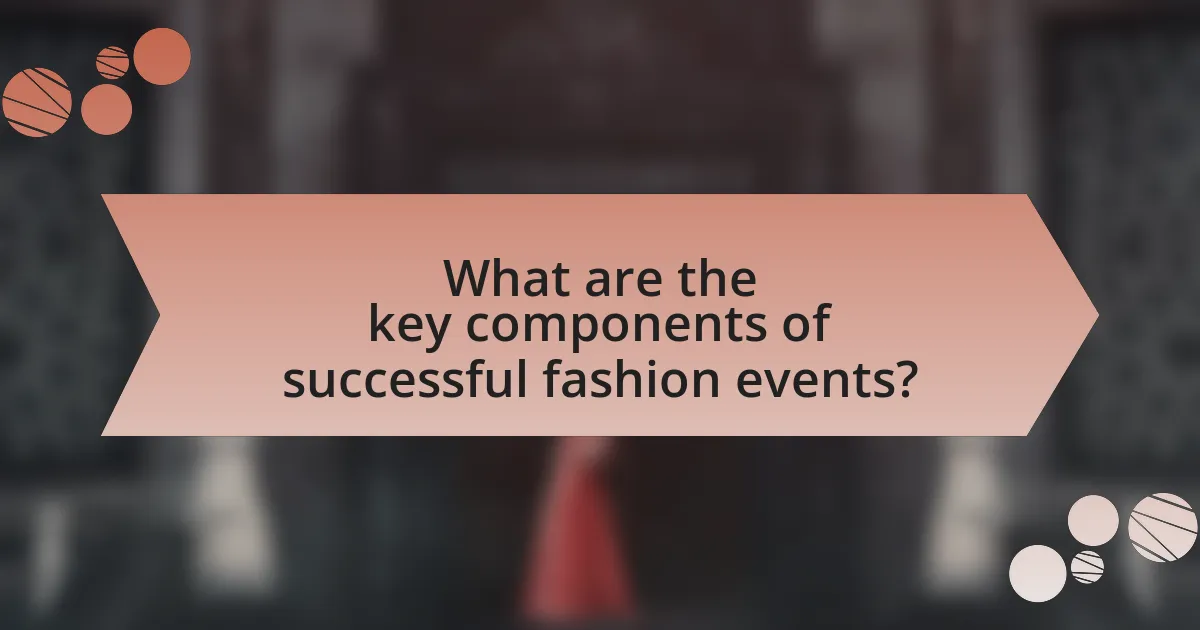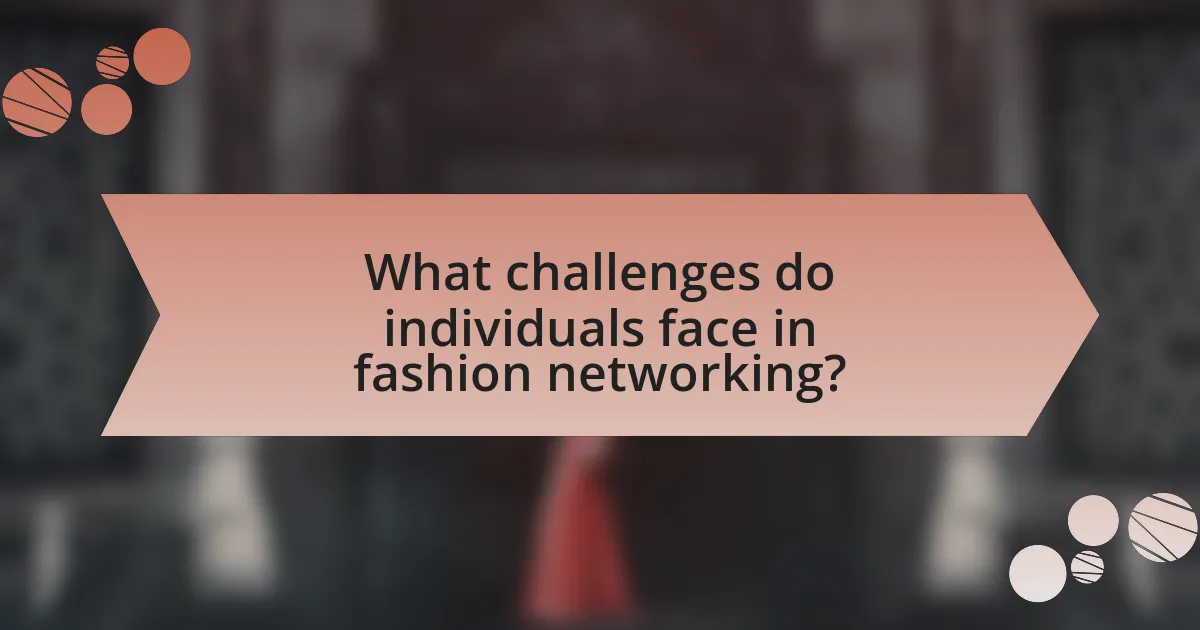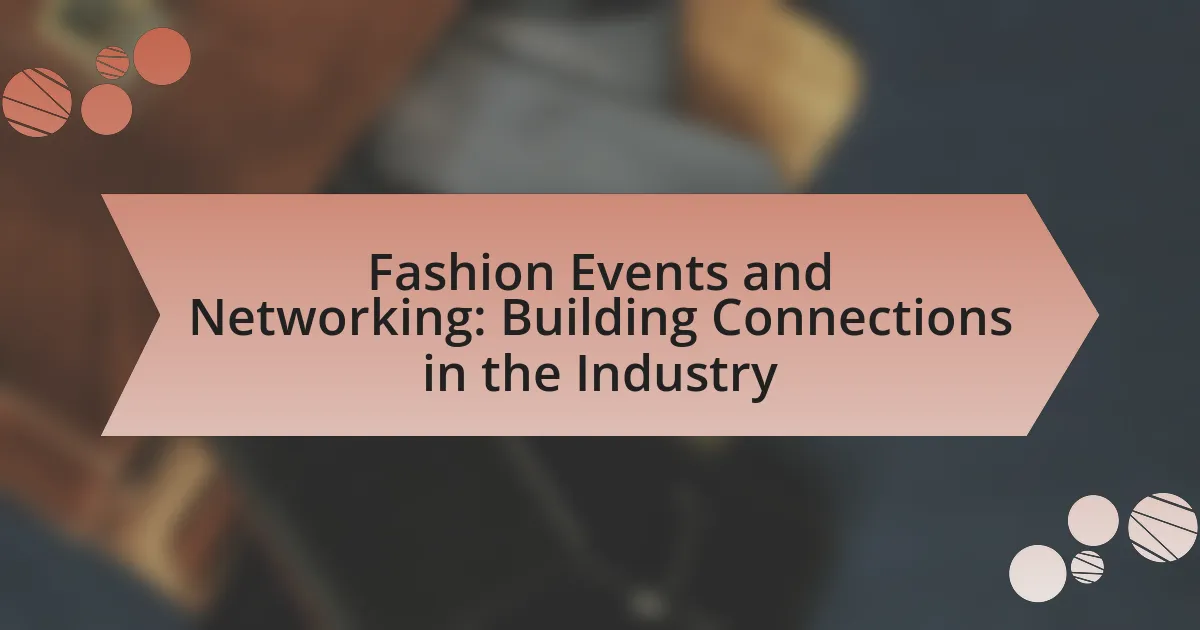Fashion events are organized gatherings in the fashion industry that serve as platforms for designers, brands, and professionals to showcase their work and facilitate networking. These events, such as New York Fashion Week and trade shows like MAGIC in Las Vegas, create opportunities for attendees to build relationships, share knowledge, and explore business collaborations. Networking is essential in the fashion industry, as it can lead to career advancements and business opportunities, with a significant percentage of jobs filled through connections. The article outlines the types of effective fashion events for networking, strategies for attendees to maximize their engagement, and the importance of follow-up actions in maintaining professional relationships. Additionally, it addresses challenges faced in networking and offers techniques for overcoming anxiety and building confidence in networking situations.

What are Fashion Events and Networking in the Industry?
Fashion events are organized gatherings in the fashion industry where designers, brands, and industry professionals showcase their work, such as runway shows, trade shows, and exhibitions. Networking in the industry refers to the process of building relationships and connections among these professionals to foster collaboration, share knowledge, and create business opportunities. Events like New York Fashion Week and trade fairs like MAGIC in Las Vegas serve as platforms for networking, allowing attendees to meet potential partners, clients, and influencers, thereby enhancing their visibility and market reach.
How do fashion events facilitate networking opportunities?
Fashion events facilitate networking opportunities by bringing together industry professionals, designers, influencers, and potential collaborators in a shared space. These events create an environment conducive to relationship-building through structured activities such as panel discussions, workshops, and informal social gatherings. For instance, events like New York Fashion Week attract thousands of attendees, providing a platform for individuals to connect, exchange ideas, and explore potential partnerships. The concentrated presence of key players in the fashion industry at these events enhances the likelihood of meaningful interactions, thereby fostering professional relationships that can lead to future collaborations and career advancements.
What types of fashion events are most effective for networking?
Fashion trade shows and fashion weeks are the most effective types of fashion events for networking. These events gather industry professionals, including designers, buyers, and influencers, creating an environment conducive to building valuable connections. For instance, events like New York Fashion Week and Paris Fashion Week attract a global audience, facilitating interactions that can lead to collaborations and partnerships. Additionally, trade shows such as MAGIC in Las Vegas provide opportunities for networking through scheduled meetings and informal gatherings, enhancing relationship-building among participants.
How do attendees typically engage with each other at these events?
Attendees typically engage with each other at fashion events through networking activities, discussions about trends, and collaborative opportunities. These interactions often occur during scheduled networking sessions, panel discussions, and informal gatherings, allowing participants to share insights and establish professional relationships. Research indicates that 85% of attendees at industry events prioritize networking as a key objective, highlighting the importance of these engagements in fostering connections within the fashion industry.
Why is networking important in the fashion industry?
Networking is crucial in the fashion industry because it facilitates connections that can lead to career opportunities, collaborations, and access to resources. In an industry where relationships often dictate success, professionals rely on networking to gain visibility and credibility. For instance, a survey by the Council of Fashion Designers of America found that 85% of fashion jobs are filled through networking, highlighting its significance in securing employment and advancing careers. Additionally, networking allows individuals to stay informed about industry trends and innovations, further enhancing their professional growth and adaptability.
What role does networking play in career advancement?
Networking plays a crucial role in career advancement by facilitating connections that can lead to job opportunities, mentorship, and industry insights. Professionals who actively engage in networking often gain access to unadvertised job openings, as many positions are filled through referrals rather than traditional hiring processes. According to a LinkedIn survey, 85% of jobs are filled through networking, highlighting its significance in career progression. Additionally, networking allows individuals to build relationships with industry leaders, which can provide valuable guidance and support in navigating career paths.
How can networking lead to business opportunities in fashion?
Networking can lead to business opportunities in fashion by facilitating connections that result in collaborations, partnerships, and access to resources. In the fashion industry, relationships built through networking events, trade shows, and social media can open doors to new clients, investors, and suppliers. For instance, a study by the Fashion Institute of Technology found that 85% of jobs in the fashion industry are filled through networking, highlighting its critical role in career advancement and business growth. Additionally, established professionals often share insights and opportunities with their network, further enhancing the potential for business development.

What are the key components of successful fashion events?
The key components of successful fashion events include effective planning, strategic marketing, engaging content, and strong networking opportunities. Effective planning ensures that all logistical aspects, such as venue selection, scheduling, and technical requirements, are meticulously organized to create a seamless experience. Strategic marketing, which may involve social media campaigns and influencer partnerships, is crucial for attracting the right audience and generating buzz around the event. Engaging content, such as innovative fashion presentations and interactive experiences, captivates attendees and enhances their overall experience. Finally, strong networking opportunities facilitate connections among industry professionals, fostering relationships that can lead to future collaborations. These components collectively contribute to the success of fashion events, as evidenced by industry standards and best practices observed in notable events like New York Fashion Week, which emphasizes the importance of these elements for achieving impactful outcomes.
How do event organizers create engaging experiences?
Event organizers create engaging experiences by incorporating interactive elements, personalized content, and networking opportunities. They utilize technology, such as event apps and social media, to facilitate real-time engagement and feedback, enhancing attendee participation. For instance, studies show that events featuring interactive sessions, like workshops or live polls, increase attendee satisfaction by up to 70%. Additionally, organizers often curate experiences that resonate with the target audience’s interests, ensuring relevance and connection. By fostering an environment that encourages networking through structured activities, such as speed networking or breakout sessions, organizers help attendees build valuable industry connections, which is crucial in the fashion sector.
What elements contribute to a memorable fashion event?
A memorable fashion event is primarily defined by its unique theme, high-quality production, and influential attendees. The theme sets the tone and can create a lasting impression, while high-quality production, including lighting, sound, and staging, enhances the overall experience. Influential attendees, such as designers, celebrities, and industry leaders, contribute to the event’s prestige and networking opportunities. According to a study by the Fashion Institute of Technology, events that incorporate interactive elements and innovative presentations are more likely to be remembered by attendees, reinforcing the importance of engagement in creating memorable experiences.
How can technology enhance networking at fashion events?
Technology enhances networking at fashion events by facilitating real-time communication and connection through digital platforms. For instance, mobile applications designed for events allow attendees to create profiles, share contact information, and schedule meetings, which increases the likelihood of meaningful interactions. Additionally, social media platforms enable participants to engage with each other before, during, and after the event, broadening their networking opportunities. According to a study by Eventbrite, 95% of event organizers believe that technology improves attendee engagement, demonstrating its effectiveness in fostering connections within the fashion industry.
What strategies can attendees use to maximize networking at events?
Attendees can maximize networking at events by actively engaging with others through strategic approaches such as preparing an elevator pitch, utilizing social media for pre-event connections, and following up post-event. Preparing an elevator pitch allows attendees to succinctly introduce themselves and their interests, making a memorable first impression. Utilizing social media platforms like LinkedIn enables attendees to connect with other participants before the event, fostering familiarity and increasing the likelihood of meaningful interactions. Following up with new contacts after the event solidifies connections and opens the door for future collaborations. These strategies are supported by research indicating that effective networking can lead to increased opportunities and partnerships within the fashion industry.
How should attendees prepare for networking at fashion events?
Attendees should prepare for networking at fashion events by researching the event, identifying key individuals to connect with, and practicing their elevator pitch. Researching the event allows attendees to understand the agenda, speakers, and brands involved, which facilitates meaningful conversations. Identifying key individuals, such as designers, influencers, or industry leaders, helps attendees focus their networking efforts on those who align with their goals. Practicing an elevator pitch ensures that attendees can succinctly communicate their background and interests, making a strong first impression. These strategies are supported by industry insights that emphasize the importance of preparation in successful networking.
What follow-up actions are essential after meeting new contacts?
Essential follow-up actions after meeting new contacts include sending a personalized thank-you email, connecting on professional networking platforms, and scheduling a follow-up meeting or call. Sending a thank-you email reinforces the connection and expresses appreciation, which can enhance relationship-building. Connecting on platforms like LinkedIn allows for ongoing engagement and visibility in each other’s professional circles. Scheduling a follow-up meeting or call provides an opportunity to discuss potential collaborations or further networking, solidifying the initial interaction. These actions are supported by research indicating that timely follow-ups significantly increase the likelihood of maintaining professional relationships, as noted in studies on networking effectiveness.

What challenges do individuals face in fashion networking?
Individuals face several challenges in fashion networking, including competition, lack of access to influential contacts, and the pressure to maintain a personal brand. The fashion industry is highly competitive, making it difficult for newcomers to stand out and establish meaningful connections. Many individuals struggle to gain access to key industry players, as networking often relies on existing relationships and insider knowledge. Additionally, the expectation to curate a personal brand can create pressure, leading to anxiety and self-doubt, which can hinder effective networking. These challenges are supported by industry reports indicating that 70% of jobs in fashion are filled through networking, highlighting the importance of connections in overcoming these barriers.
How can introverts effectively network in the fashion industry?
Introverts can effectively network in the fashion industry by leveraging one-on-one interactions and utilizing digital platforms. Engaging in smaller, more intimate settings allows introverts to build deeper connections, as they often thrive in environments where they can have meaningful conversations rather than large group interactions. Additionally, using social media and professional networking sites like LinkedIn enables introverts to connect with industry professionals at their own pace, facilitating relationships without the immediate pressure of face-to-face encounters. Research indicates that introverts often excel in networking when they prepare specific topics or questions in advance, which can lead to more productive discussions and lasting connections.
What techniques can help overcome networking anxiety?
Techniques to overcome networking anxiety include preparation, practice, and reframing negative thoughts. Preparation involves researching attendees and formulating conversation starters, which can increase confidence. Practicing networking skills in low-pressure environments, such as with friends or colleagues, helps build comfort. Reframing negative thoughts into positive affirmations can reduce anxiety; for example, viewing networking as an opportunity to learn rather than a performance can shift perspective. These methods are supported by psychological studies indicating that preparation and cognitive restructuring effectively reduce anxiety in social situations.
How can one build confidence in networking situations?
To build confidence in networking situations, one should prepare thoroughly by researching attendees and practicing conversation starters. Preparation allows individuals to feel more knowledgeable and ready to engage, which significantly boosts confidence. Studies show that individuals who practice their networking skills report higher levels of comfort and success in social interactions. For instance, a survey by LinkedIn found that 85% of jobs are filled through networking, highlighting the importance of effective communication in these scenarios.
What common mistakes should be avoided during networking?
Common mistakes to avoid during networking include failing to research contacts beforehand, which can lead to uninformed conversations. Engaging in one-sided discussions without listening to others can alienate potential connections. Additionally, neglecting to follow up after initial meetings diminishes the chance of building lasting relationships. According to a study by the Harvard Business Review, effective networking relies on mutual benefit and engagement, highlighting the importance of active listening and follow-up in establishing strong professional ties.
How can poor communication hinder networking efforts?
Poor communication can significantly hinder networking efforts by creating misunderstandings and reducing the effectiveness of interactions. When individuals fail to convey their ideas clearly, potential connections may misinterpret intentions or overlook opportunities for collaboration. For instance, a study by the International Journal of Business Communication found that 70% of professionals believe that poor communication negatively impacts their ability to network effectively. This lack of clarity can lead to missed opportunities, as individuals may not fully grasp the value or relevance of what others offer, ultimately stunting relationship-building in the fashion industry.
What are the pitfalls of superficial networking?
Superficial networking often leads to weak professional relationships that lack depth and trust. This type of networking can result in missed opportunities for collaboration, as individuals may not feel comfortable sharing valuable insights or resources with someone they perceive as insincere. Additionally, superficial connections can create a false sense of security, where individuals believe they have a robust network, but in reality, they lack meaningful contacts who can provide support or guidance. Research indicates that strong ties, characterized by deeper relationships, are more beneficial for career advancement than weak ties, which are often the result of superficial networking.
What are the best practices for building lasting connections in fashion?
The best practices for building lasting connections in fashion include actively participating in industry events, fostering genuine relationships, and leveraging social media for networking. Engaging in fashion shows, trade fairs, and networking events allows individuals to meet key players in the industry, while building authentic relationships based on mutual interests and respect enhances trust and collaboration. Additionally, utilizing platforms like Instagram and LinkedIn to connect with industry professionals can expand one’s network and maintain ongoing communication. Research indicates that 85% of jobs are filled through networking, highlighting the importance of these practices in establishing a successful career in fashion.
How can authenticity enhance networking relationships?
Authenticity enhances networking relationships by fostering trust and genuine connections among individuals. When people present their true selves, it encourages openness and vulnerability, which are essential for building meaningful relationships. Research indicates that authentic interactions lead to stronger bonds, as individuals are more likely to engage with those they perceive as sincere. For instance, a study published in the Journal of Business and Psychology found that authenticity in professional settings significantly correlates with relationship quality and networking effectiveness. This demonstrates that being genuine not only attracts like-minded individuals but also facilitates deeper, more productive connections in the fashion industry.
What role does follow-up play in maintaining connections?
Follow-up plays a crucial role in maintaining connections by reinforcing relationships and demonstrating continued interest. In the context of fashion events and networking, timely follow-ups can lead to deeper collaborations and opportunities, as they show professionalism and commitment. Research indicates that 80% of sales require five follow-ups after the initial contact, highlighting the importance of persistence in nurturing connections. By reaching out after an event, individuals can remind their contacts of shared experiences, solidify their presence in the industry, and open doors for future interactions.
